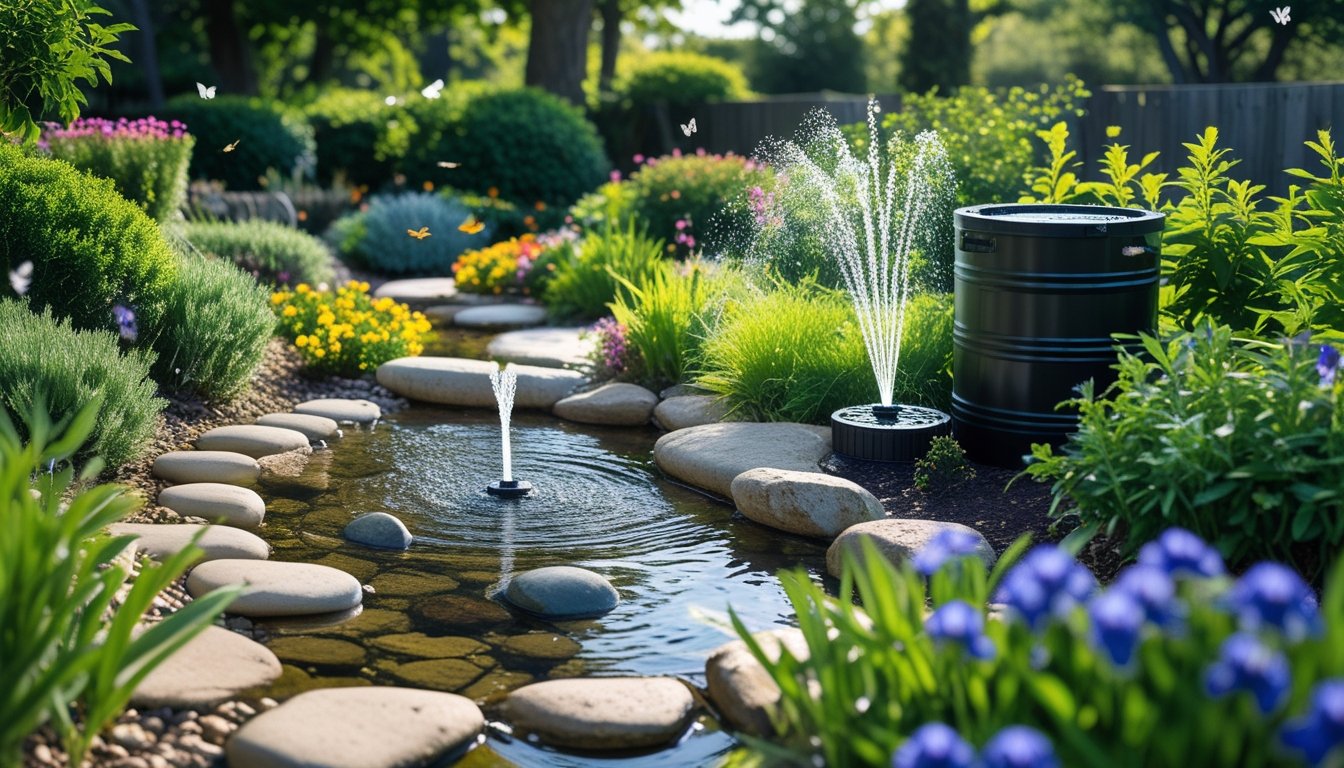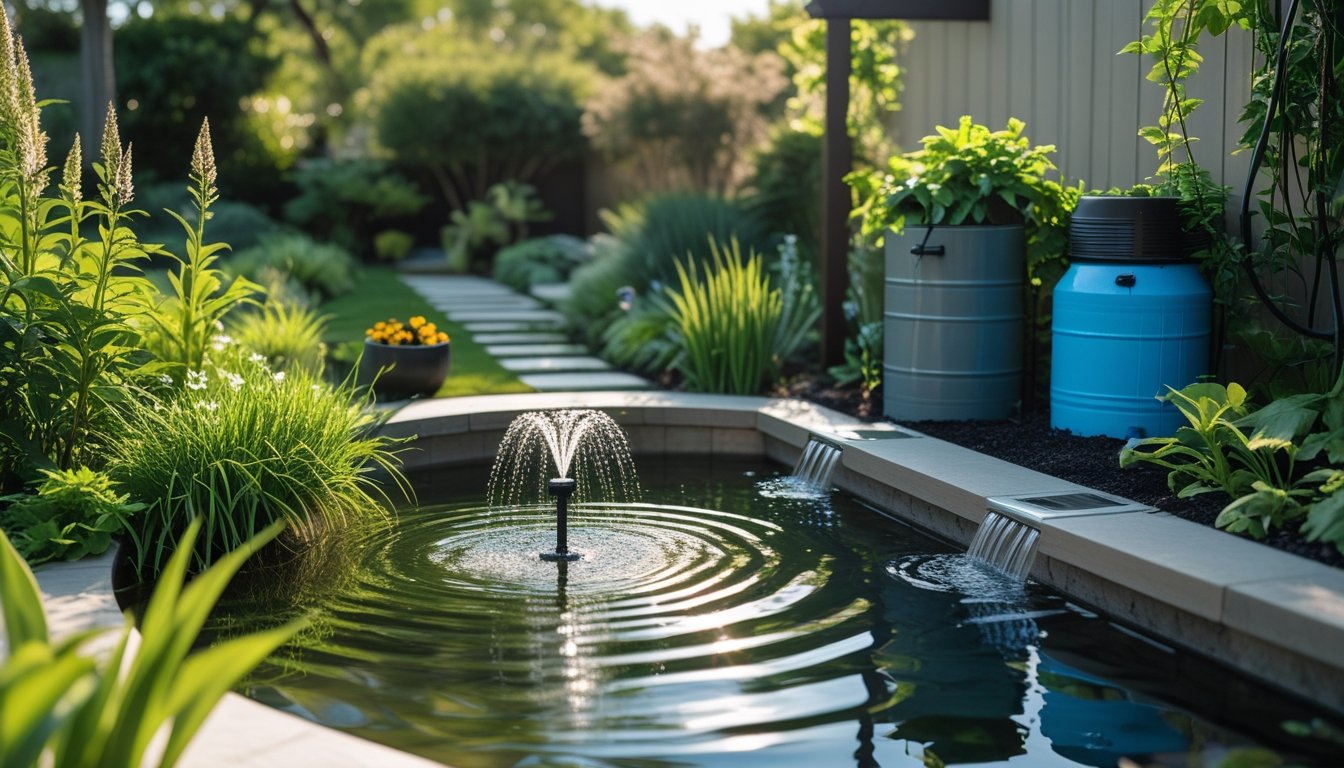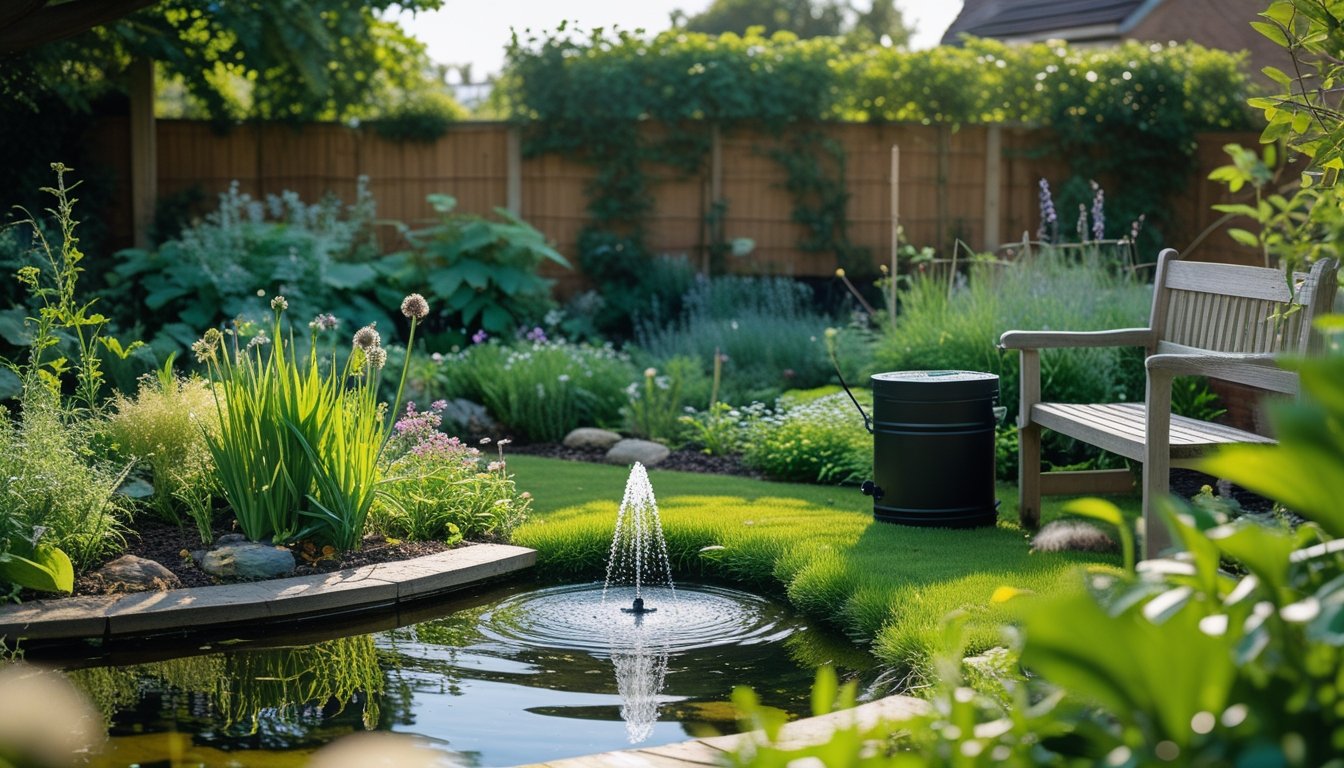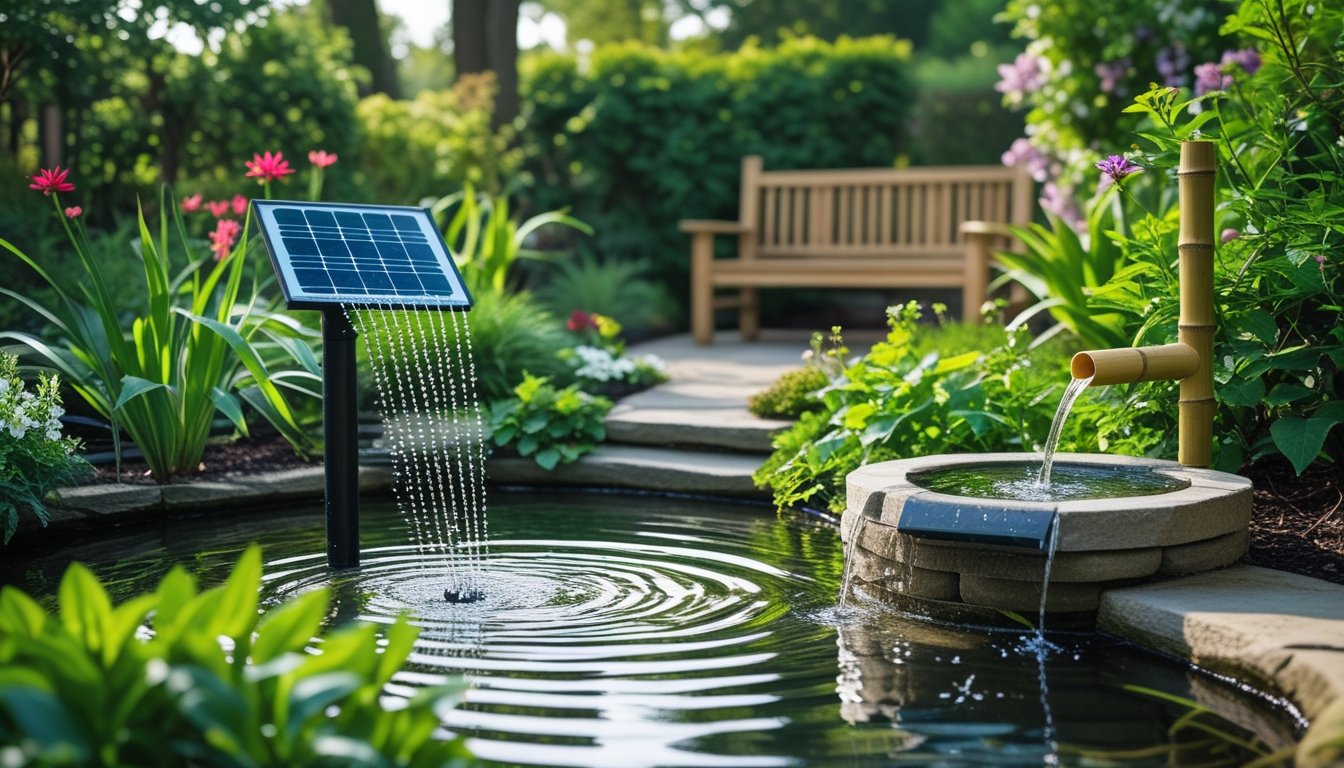Late updated: 15 Aug 2025 10:08
Written by: James Whitaker
Enhance Your Garden With Eco-Friendly Water Features: Sustainable Ideas for Every Space
Stepping into the realm of eco-friendly water features invites us into a serene, sustainable gardening style that delights both the eyes and the environment. As water features are becoming increasingly popular among environmentally-conscious gardeners, integrating them thoughtfully into our landscapes can bring substantial ecological benefits. Eco-friendly water features can dramatically enhance our garden's aesthetic while conserving resources and supporting local wildlife.

By harnessing renewable energy sources and employing sustainable designs, we can enjoy the soothing presence of water without a hefty environmental cost. Solar-powered fountains and rainwater-fed ponds not only reduce our carbon footprint but also promote biodiversity by attracting native species. Choosing the right materials and design for these features is key, as they ensure efficiency and minimise waste, transforming our gardens into true eco-sanctuaries.
Key Takeaways
- Eco-friendly water features save resources and attract wildlife.
- Solar-powered and rainwater-fed designs minimise environmental impact.
- Material and design choice are crucial for efficiency and sustainability.
Key Strategies to Enhance Your Garden With Eco-Friendly Water Features

When creating a garden with eco-friendly water features, there are several strategies to consider. Sustainable materials, water conservation, renewable energy sources, and biodiversity all play pivotal roles. Implementing these can transform an ordinary garden into a sustainable haven.
Choosing Sustainable Materials and Designs
For a truly eco-friendly water feature, selecting sustainable materials is essential. One approach is to use recycled materials like repurposed stones and wood. These materials not only reduce waste but also lower the carbon footprint. Designs should highlight natural elements, blending seamlessly with the environment.
It's crucial to choose designs that prioritise natural filtration systems. Such systems utilise native aquatic plants to purify the water naturally. This not only supports the ecosystem but also reduces the need for mechanical filtration, which can be energy-intensive.
Water Conservation Techniques for Garden Features
Water conservation is at the heart of sustainable gardening. Incorporating rainwater harvesting systems ensures that the garden's water features require minimal municipal water. Utilising permeable surfaces around the water feature can help absorb excess water, making every drop count.
Including automated irrigation systems equipped with moisture sensors can optimise water usage. This ensures that water features stay functional without wasting resources. Practice careful maintenance, sealing any leaks promptly to prevent unnecessary water loss.
Integrating Renewable Energy Sources
To further enhance sustainability, consider integrating solar panels to power the garden's water features. Solar-powered pumps are perfect for circulating water, eliminating the need for grid electricity. This utilisation of renewable energy enhances the garden’s energy efficiency and reduces ongoing costs.
Solar lighting can also be incorporated to illuminate water features at night. This not only adds beauty but ensures that the garden remains energy-efficient after sunset.
Promoting Biodiversity with Aquatic Plants
A diversity of native aquatic plants within your water features fosters a healthy ecosystem. Water lilies, sedges, and other native species support local wildlife while naturally filtering the water. These plants attract beneficial insects and birds, boosting the garden's ecological balance.
Including a variety of plants is key to promoting biodiversity. Each species can provide different benefits, such as shading water to reduce evaporation or offering habitats for aquatic life. It's important to research which species are native to your area to best support local biodiversity.
By effectively implementing these strategies, our gardens not only enhance their aesthetic appeal but also contribute positively to the environment. Sustainable practices ensure that our water features remain eco-friendly and in harmony with nature.
Practical Types of Eco-Friendly Water Features for UK Gardens

UK gardens can embrace sustainability by incorporating various types of eco-friendly water features. These elements not only add aesthetic appeal but also help conserve energy and water. By exploring options like solar-powered fountains, pondless waterfalls, and rainwater harvesting systems, we can create a garden oasis that aligns with environmentally-friendly practices.
Solar-Powered Fountains and Pumps
Solar-powered fountains and pumps offer an eco-friendly solution for garden water features, harnessing the power of the sun. These systems eliminate the need for external electricity, significantly reducing our energy consumption. Solar panels integrated into the design capture sunlight, which drives the operation of the pump and circulates water.
Installation is straightforward, usually involving connecting solar panels to a submersible pump. A solar-powered pump keeps maintenance minimal, as it doesn’t require electrical wiring. Moreover, these fountains provide the soothing sounds and visual appeal of flowing water without inflating our energy bills.
LED lighting can be paired with solar fountains to enhance night-time aesthetics while maintaining low energy usage. Cost-effective and sustainable, they are perfect for UK gardens aiming to reduce their carbon footprint.
Pondless Waterfalls and Waterfalls
Pondless waterfalls present an innovative way to enjoy the beauty of waterfalls without a traditional pond. These features consist of a circulating waterfall with a hidden reservoir underground, making them safer and easier to maintain than traditional ponds. Water is continuously pumped over stones or rocks, creating a cascade effect that is both visually stunning and calming.
Energy-efficient pumps help to circulate the water, keeping our energy usage low. These systems can be customised with various natural materials such as stones or gravel, allowing us to blend the waterfall seamlessly into the existing landscape.
Without the need for a permanent water body, pondless waterfalls are space-efficient and ideal for gardens where safety is a concern, especially around children.
Rainwater Harvesting Systems
Rainwater harvesting systems are a practical way to enhance an eco-friendly garden. By collecting and storing rainwater, we can use this natural resource to sustain our water features and keep our garden lush during dry periods. A rainwater harvesting system often includes a collection area, storage tanks, and a distribution method.
These systems are beneficial in reducing dependence on mains water supply, cutting water costs and conserving valuable resources. Rainwater can be easily directed to feed water features, lawns, and garden beds through submersible pumps.
The integration of rainwater systems in our garden promotes sustainability and helps mitigate water wastage. It’s an intelligent way to maintain vibrant green spaces while supporting environmental stewardship.
Energy-Efficient Pumps and Filtration Systems
Modern water features benefit greatly from the use of energy-efficient pumps and filtration systems. By opting for these technologies, we ensure that our garden water elements operate sustainably. Energy-efficient pumps are designed to use less power yet provide sufficient flow to keep water features functional.
A good filtration system ensures water clarity and reduces maintenance needs. These systems use less energy than traditional ones, improving their eco-friendliness. They also play a vital role in preventing algae growth, keeping the water clean and reducing the frequency of clean-ups.
Given the range of options available, incorporating energy-efficient technology is both a cost-effective and a responsible choice for any eco-conscious gardener. A well-chosen setup enhances our garden while supporting its ecological balance.
Frequently Asked Questions

Integrating eco-friendly water features into our gardens can offer numerous benefits, such as attracting wildlife, conserving water, and reducing energy use. We'll explore how to select sustainable materials and ensure minimal environmental impact.
How can I attract wildlife to my garden with an eco-friendly water feature?
To attract wildlife, consider installing features like shallow edges for easy access and planting native species nearby. This simple addition offers creatures a habitat and encourages biodiversity.
What are the benefits of using a solar-powered water fountain in a garden?
Solar-powered fountains reduce electricity consumption and leave a smaller carbon footprint. By harnessing solar energy, these fountains help us lower utility costs while maintaining a sustainable feature in our garden.
Which materials are considered sustainable for creating a garden water feature?
Sustainable materials include reclaimed stone, recycled metal, and sustainably sourced wood. Using these materials supports environmental efforts by reducing the need for new resources and lowering waste.
How does one establish a rain garden to conserve water in an outdoor space?
Rain gardens are designed to capture runoff from roofs and other surfaces. To create one, we use water-absorbing plants in a shallow depression, allowing water to replenish the water table naturally.
What are the steps to ensure a garden fountain operates efficiently with minimal environmental impact?
Efficient operation involves regular maintenance and use of energy-efficient pumps. We should also choose systems designed to minimise water waste while keeping the feature clean and functional.
Can you create a wildlife water station that supports local biodiversity without wasting water?
A wildlife water station can be created using low-water designs such as bird baths with slow-drip feeders. This method ensures species have access to fresh water while conserving valuable resources.
